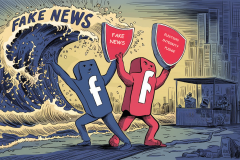Over the weekend, a chart from the Flowing Data blog “revealed” that Facebook applications, on the whole, are silly. Much of the discussion that followed was of the patronizing “see, we told you Facebook apps were dumb” variety. Nevermind that the category data is based on developer defined categorization (i.e., this is how the apps makers see their apps, not necessarily how users might classify them), the real reason there are so many fun apps on Facebook is because the distribution channels are biased toward their success, or so says Ben Rattray of Change.org.

That Facebook will eventually morph into a network suitable for both work and play is an argument I’ve made on ReadWriteWeb in the past. But as we noted a couple of weeks ago, in spite of Facebook already being in wide use in the business community, it has yet to shed its fun image. On top of there being fewer “useful” apps, the ones that do exist also aren’t being used as often.
According to Rattray, that’s because the Facebook platform is biased against them. “The only way for a Facebook app to get any sort of distribution is to have a viral coefficient over 1. This is an extremely high barrier for any app in which inviting friends is not an inherent part of using it,” writes Rattray in an email republished on Andrew Chen’s blog.
Fun Apps are Built to Go Viral
Utility apps on Facebook rely on word of mouth to spread, while “fun” apps tend to use the platform’s built in viral action mechanisms (friend invites, news feed stories, etc.). It becomes exceptionally difficult for utility apps to achieve a viral coefficient above 1 when relying solely on word of mouth — or people talking about their app because they’re excited to use it. In otherwords, “Witchdoctors vs. Shopping Mall Security Guards” will get very popular because it has a built in viral transmission mechanism (invite friends), but most utility apps don’t have that — you don’t need to invite your friends to an application that manages your schedule, and there are fewer chances for news feed insertions — and so must rely on word of mouth.
Facebook actually compounds the problem because the sheer number of apps has created noise and made it less likely for people to accept invites. “Given current invitation conversation rates of 5% or less (at least what I’m hearing), for an app to go viral, you have to get people to invite an average of at least 20 friends,” says Rattray. “How many utility based apps can achieve that? How many inspire so much passion that its users tell 20 friends, on average? Few, even if people find the app incredibly useful.”
Rattray also compares the Facebook platform to one of history’s most successful computing platform plays: Windows. Windows apps, he says, are rarely viral. Instead, they gain users via distribution deals with big box electronics stores, of which the application directory is the Facebook equivalent. But the directory is so overloaded with choices that it has become virtually useless as a distribution tool. To the extent that it is used, which apps get top billing? Largely the silly viral applications that tend to be the most popular for reasons already stated.
The Solution
“As a final note,” writes Rattray, “[…] it seems almost certain that Facebook itself didn’t realize when they launched the platform that they created a system in which it was nearly impossible to achieve the very thing they claimed to seek — greater utility.” Facebook is now trying to remedy the situation by tweaking rules about app invites and news feed insertions, but making it easier for useful apps which have no built in viral mechanism to go viral on the network is itself not an easy task. Rattray suggests an overhauled directory that is perhaps personalized for each user based on app ratings gleaned from their social graph.
In a follow up email to Chen, Rattray wonders if perhaps Facebook users just aren’t interested in useful apps — a common sentiment in comments here whenever I make a post on this topic. “I think it’s possible that Facebook users as a whole just aren’t that interested in utility-based apps,” he concedes. “But I also think that a strong argument can be made that Facebook could be a compelling utility.” Because of the way distribution on the platform is set up, it’s a question that can’t really be answered until useful apps have been given their fair shake at exposure.
According to Rattray, “From a business standpoint, if Facebook wants to keep their core audience engaged beyond college, attract an older audience that has never used Facebook, and better monetize both groups, they’re going to do more than offer fun ways to communicate with friends.”










